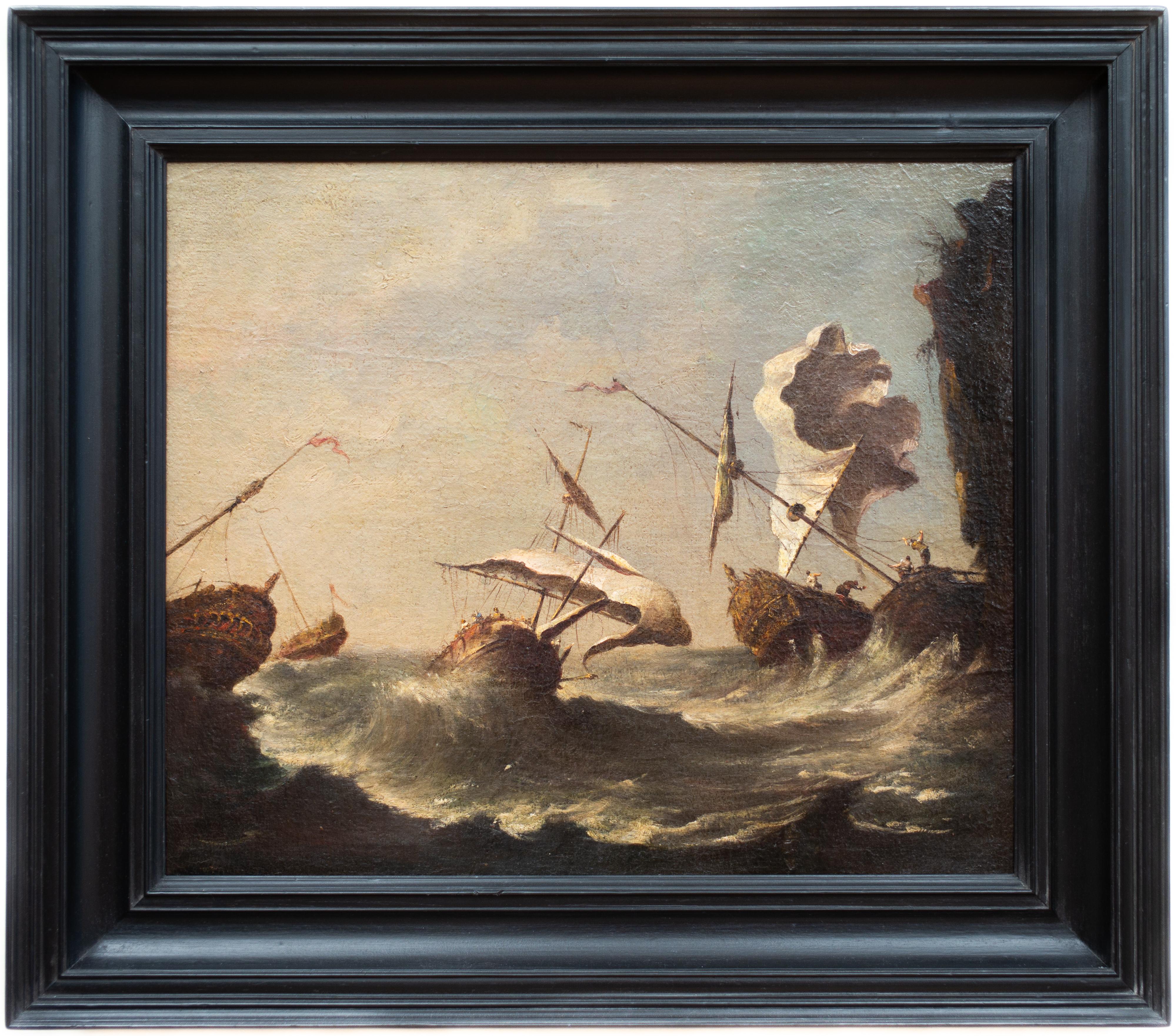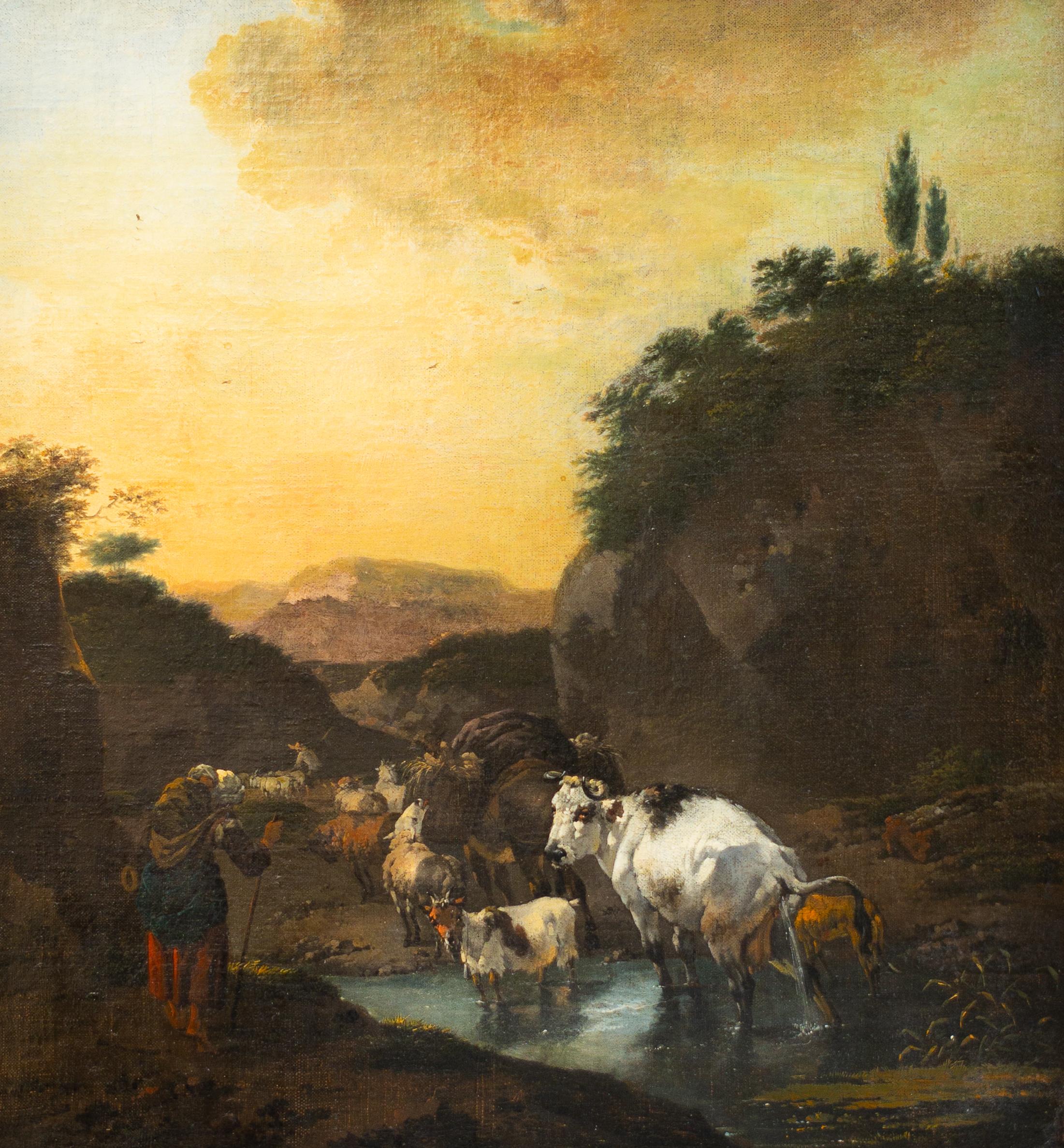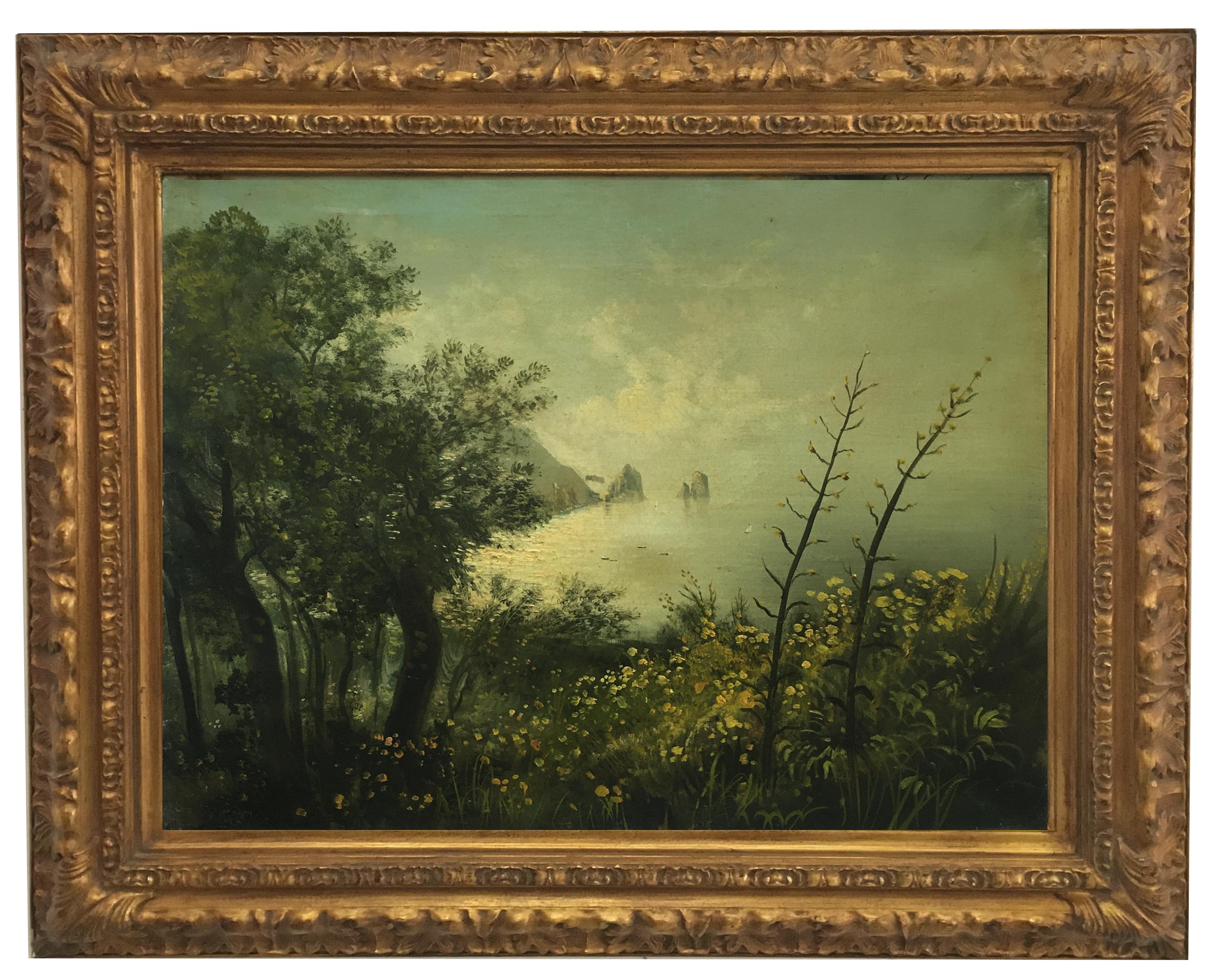Items Similar to Claude-Joseph Vernet 18th century Old Master landscape, grand tour Italy
Want more images or videos?
Request additional images or videos from the seller
1 of 12
Claude-Joseph VernetClaude-Joseph Vernet 18th century Old Master landscape, grand tour Italy
About the Item
Claude-Joseph Vernet (French, 1714 – 1789)
Fisherman by a cascade in a gorge
Oil on canvas
22.1/4 x 25.1/2 in. (56.5 x 64.7 cm.)
Provenance:
The estate of the late Betty, Lady Grantchester
Du Catalogue Collection #39
Christie's London, 3 Dec 1997, Lot 52 (£41,000)
Claude-Joseph Vernet was the leading French landscape painter (with Hubert Robert) of the later 18th century. He achieved great celebrity with his topographical paintings and serene landscapes. He was also one of the century's most accomplished painters of tempests and moonlight scenes.Vernet was born at Avignon and trained there with his father, Antoine, and with the history painter Philippe Sauvan. He spent the years 1734 to 1752 in Rome, where he studied classical landscapes in the tradition of Claude and Gaspard Dughet, as well as the dramatic paintings of Salvator Rosa. In Rome he was influenced by the contemporary Roman topographical painter Giovanni Paolo Panini. He had many English clients and admirers in Rome, including Richard Wilson, whom Vernet is thought to have encouraged as a landscape painter.Vernet became a member of the Academy on his return to France and in 1753 received the important royal commission for a series of large canvases representing the ports of France (1753-65).
- Creator:Claude-Joseph Vernet (1714 - 1789, French)
- Dimensions:Height: 22.25 in (56.52 cm)Width: 25.5 in (64.77 cm)Depth: 1 in (2.54 cm)
- Medium:
- Movement & Style:
- Period:
- Condition:Oil on canvas, relined. Paint surface in good order, recently cleaned and varnished (ask for photographs post restoration). In an expensive gilded frame.
- Gallery Location:Petworth, GB
- Reference Number:1stDibs: LU54038029892
About the Seller
4.9
Platinum Seller
These expertly vetted sellers are 1stDibs' most experienced sellers and are rated highest by our customers.
Established in 2010
1stDibs seller since 2017
230 sales on 1stDibs
Typical response time: 2 hours
- ShippingRetrieving quote...Ships From: Petworth, United Kingdom
- Return PolicyA return for this item may be initiated within 10 days of delivery.
More From This SellerView All
- Large oil paintings of Gulls at St. Ives bay, Cornwall by British artist TitcombLocated in Petworth, West SussexWilliam Holt Yates Titcomb (British, 1858 – 1930) Gulls at St. Ives bay Oil on canvas Signed ‘W. H. Y. TITCOMB’ (lower right) 34 x 44 in. (86.3 x 111.8 cm.) Frame measurements: 110.3 x 136 cm.) William Holt Yates Titcomb (1858 - 1930) was an English artist. He was a figurative oil painter, particularly known for his depictions of the Cornish fisherfolk. Titcomb was born in Cambridge, the eighth child and first son of the Rev. Jonathan Holt Titcomb and his wife Sarah. He was educated at Westminster School in London and began his art training at the South Kensington School. His father was appointed the first Bishop of Rangoon, Burma in 1877 and Titcomb joined him there in December 1880. In Burma he made a series of paintings and sketches of life in the local monasteries. Titcomb was taught in Paris by Gustave Boulanger and at the Royal College of Art in Antwerp by Charles Verlat. He married Jessie Ada Morison, in 1892. She was also an artist, living at the time in St. Ives, Cornwall. His painting Primitive Methodists at Prayer, was displayed at the Dudley Museum and Art Gallery in 1889. It won many international medals and was the first of three paintings that Titcomb completed of the Primitive Methodist congregation of Fore street, St. Ives. In 1909, Titcomb settled in Bristol, where he was already an elected Academician of the Bristol Academy...Category
Early 20th Century Academic Animal Paintings
MaterialsOil, Canvas
- 20th Century American abstract landscape in purples and bluesLocated in Petworth, West SussexRobin Richmond (American, b.1951 Quilt with sever barns Signed and dated ‘Robin Richmond / 1988’ (lower right) Oil on canvas 30 x 48 in. (76.2 x 122 cm.) Provenance: With the Mercury...Category
20th Century Abstract Landscape Paintings
MaterialsOil, Canvas
- Post Impressionist work of Notre Dame, early 20th Century by Charles WittmannLocated in Petworth, West SussexCharles Wittmann (French, 1876 – 1953) Notre dame, Paris Oil on canvas Signed ‘CH. WITTMANN’ (lower right) 31.5/8 x 31.7/8 in. (80.3 x 81.2 cm.) Son ...Category
20th Century Post-Impressionist Landscape Paintings
MaterialsOil, Canvas
- British 19th Century oil painting of a mill at the riverside by Alfred VickersLocated in Petworth, West SussexAlfred H. Vickers (British, 1853-1907) A Mill at the Riverside Oil on canvas Signed, ‘A.H Vickers.’ (lower right) 10 x 12 1/8 in. (25.5 x 31 cm.)Category
19th Century Academic Landscape Paintings
MaterialsCanvas, Oil
- Post Impressionist oil painting of a street scene in Toul, FranceLocated in Petworth, West SussexCharles Wittmann (French, 1876 – 1953) Le Vieux Toul Oil on canvas Signed ‘CH. WITTMANN’ (lower left) 25.3/4 x 21.1/4 in. (65.5 x 54 cm.) Recently re...Category
20th Century Post-Impressionist Landscape Paintings
MaterialsOil, Canvas
- British 20th Century oil painting 'Harvest on the Causse' by Hugh CroninLocated in Petworth, West SussexHugh Cronyn (British, 1905 – 1996) Harvest on the Causse Oil on canvas Signed with initial ‘H.C’ (lower right) 24 x 40.1/4 in. (61 x 102 cm.) Hugh Cronyn, of French-Canadian parentage, was born in Vancouver, Canada, in 1905. It was not until he started attending evening classes in drawing, whilst working for the Anglo-American Tea Company in Toronto between 1923 and 1928, that he received any kind of training. It was this which led him to become a student of Franz Johnston...Category
20th Century Modern Landscape Paintings
MaterialsOil, Canvas
You May Also Like
- A WolfLocated in New York, NYProvenance: The Marchesi Strozzi, Palazzo Strozzi, Florence Sale, Christie’s, London, May 20, 1993, lot 315, as by Carl Borromaus Andreas Ruthart...Category
17th Century Old Masters Animal Paintings
MaterialsPaper, Canvas, Oil
- Early oil depicting the Great Fire of LondonLocated in London, GBThe Great Fire of London in September 1666 was one of the greatest disasters in the city’s history. The City, with its wooden houses crowded together in narrow streets, was a natural fire risk, and predictions that London would burn down became a shocking reality. The fire began in a bakery in Pudding Lane, an area near the Thames teeming with warehouses and shops full of flammable materials, such as timber, oil, coal, pitch and turpentine. Inevitably the fire spread rapidly from this area into the City. Our painting depicts the impact of the fire on those who were caught in it and creates a very dramatic impression of what the fire was like. Closer inspection reveals a scene of chaos and panic with people running out of the gates. It shows Cripplegate in the north of the City, with St Giles without Cripplegate to its left, in flames (on the site of the present day Barbican). The painting probably represents the fire on the night of Tuesday 4 September, when four-fifths of the City was burning at once, including St Paul's Cathedral. Old St Paul’s can be seen to the right of the canvas, the medieval church with its thick stone walls, was considered a place of safety, but the building was covered in wooden scaffolding as it was in the midst of being restored by the then little known architect, Christopher Wren and caught fire. Our painting seems to depict a specific moment on the Tuesday night when the lead on St Paul’s caught fire and, as the diarist John Evelyn described: ‘the stones of Paul’s flew like grenades, the melting lead running down the streets in a stream and the very pavements glowing with the firey redness, so as no horse, nor man, was able to tread on them.’ Although the loss of life was minimal, some accounts record only sixteen perished, the magnitude of the property loss was shocking – some four hundred and thirty acres, about eighty per cent of the City proper was destroyed, including over thirteen thousand houses, eighty-nine churches, and fifty-two Guild Halls. Thousands were homeless and financially ruined. The Great Fire, and the subsequent fire of 1676, which destroyed over six hundred houses south of the Thames, changed the appearance of London forever. The one constructive outcome of the Great Fire was that the plague, which had devastated the population of London since 1665, diminished greatly, due to the mass death of the plague-carrying rats in the blaze. The fire was widely reported in eyewitness accounts, newspapers, letters and diaries. Samuel Pepys recorded climbing the steeple of Barking Church from which he viewed the destroyed City: ‘the saddest sight of desolation that I ever saw.’ There was an official enquiry into the causes of the fire, petitions to the King and Lord Mayor to rebuild, new legislation and building Acts. Naturally, the fire became a dramatic and extremely popular subject for painters and engravers. A group of works relatively closely related to the present picture have been traditionally ascribed to Jan Griffier...Category
17th Century Old Masters Landscape Paintings
MaterialsCanvas, Oil
- Shipping in Stormy Waters, Attributed to Italian Artist Francesco GuardiBy Francesco GuardiLocated in Stockholm, SEThe splendour of the tragic sea Francesco Guardi and maritime painting in Venetian art No Venetian painter was a stranger to the sea. After all, Venice was not only one of the most prominent ports of the Mediterranean, but indeed a city literally submerged in the ocean from time to time. Curiously however, the famous Venetian school of painting showed little interest in maritime motifs, favouring scenes from the iconic architecture of the city rather than seascapes. That is why this painting is a particularly interesting window into not only the painter Francesco Guardi himself – but to the significance of the element of water in art history, in absence as well as in the centre of attention. Whether it be calm, sunny days with stunning views of the palaces alongside the canals of Venice or – more rarely – stormy shipwrecking tragedies at sea, water as a unifying element is integral to the works of painter Francesco Guardi (1712–1793). During his lifetime, Venetian art saw many of its greatest triumphs with names like Tiepolo or Canaletto gaining international recognition and firmly establishing Venice as one of the most vibrant artistic communities of Europe. While the city itself already in the 18th century was something of an early tourist spot where aristocrats and high society visited on their grand tour or travels, the artists too contributed to the fame and their work spread the image of Venice as the city of romance and leisure to an international audience, many of whom could never visit in person. Still today, the iconic image of Venice with its whimsical array of palaces, churches and other historic buildings is much influenced by these artists, many of whom have stood the test of time like very well and remain some of the most beloved in all of art history. It was not primarily subtility, intellectual meanings or moral ideals that the Venetian art tried to capture; instead it was the sheer vibrancy of life and the fast-paced city with crumbling palaces and festive people that made this atmosphere so special. Of course, Venice could count painters in most genres among its residents, from portraiture to religious motifs, history painting and much else. Still, it is the Vedutas and views of the city that seems to have etched itself into our memory more than anything else, not least in the tradition of Canaletto who was perhaps the undisputed master of all Venetian painters. Born into his profession, Francesco lived and breathed painting all his life. His father, the painter Domenico Guardi (1678–1716) died when Francesco was just a small child, yet both he and his brothers Niccolò and Gian Antonio continued in their fathers’ footsteps. The Guardi family belonged to the nobility and originated from the mountainous area of Trentino, not far from the Alps. The brothers worked together on more challenging commissions and supported each other in the manner typical of family workshops or networks of artists. Their sister Maria Cecilia married no other than the artist Giovanni Battista Tiepolo himself, linking the family to the most renowned Venetian name of the time. During almost a decade, Guardi worked in the studio of Michele Giovanni Marieschi, sometimes simply known as Michiel, a painted similar in both style and motif. Canaletto is, however, the artist Guardi is most often compared to since they shared a mutual fascination for depicting the architecture and cityscape of Venice. During the course of his career, Guardi tried his hand in many different genres. He was as swift in painting landscapes, Vedutas of Venice, sacred motifs, interiors and architectural compositions as he was in a number of other motifs. His style is typical of the Venetian school but also distinct and personal once we look a little closer. There is an absolute certainty in the composition, the choice of which sometimes feels like that of a carefully calculated photograph – yet it is also very painterly, in the best sense of the word: fluid, bold, sensitive and full of character. The brushwork is rapid, intense, seemingly careless and extraordinarily minute at the same time; fresh and planned in a very enjoyable mixture. His interiors often capture the breath-taking spacious glamour of the palaces and all their exquisite decor. He usually constructed the motif through remarkably simple, almost spontaneous yet intuitively precise strokes and shapes. The result was a festive, high-spirited atmospheric quality, far away from the sterile and exact likeness that other painters fell victim to when trying to copy Canaletto. The painting here has nothing of the city of Venice in it. On the contrary, we seem to be transported far away into the solitary ocean, with no architecture, nothing to hold on to – only the roaring sea and the dangerous cliffs upon which the ships are just moments away from being crushed upon. It is a maritime composition evoking both Flemish and Italian precursors, in the proud tradition of maritime painting that for centuries formed a crucial part of our visual culture. This genre of painting is today curiously overlooked, compared to how esteemed and meaningful it was when our relationship to the sea was far more natural than it is today. When both people and goods travelled by water, and many nations and cities – Venice among them – depended entirely on sea fare, the existential connection to the ocean was much more natural and integrated into the imagination. The schools and traditions of maritime art are as manifold as there are countries connected to the sea, and all reflect the need to process the dangers and wonders of the ocean. It could symbolize opportunity, the exciting prospects of a new countries and adventures, prospering trade, beautiful scenery as well as war and tragedy, loss of life, danger and doom. To say that water is ambivalent in nature is an understatement, and these many layers were something that artists explored in the most wondrous ways. Perhaps it takes a bit more time for the modern eye to identify the different nuances and qualities of historic maritime paintings, they may on first impression seem hard to differentiate from each other. But when allowing these motifs to unfold and tell stories of the sea in both fiction and reality – or somewhere in between – we are awarded with an understanding of how the oceans truly built our world. In Guardi’s interpretation, we see an almost theatrically arranged shipwrecking scene. No less than five ships are depicted right in the moment of utter disaster. Caught in a violent storm, the waves have driven them to a shore of sharp cliffs and if not swallowed by the waves, crushing against the cliffs seems to be the only outcome. The large wooden ships are impressively decorated with elaborate sculpture, and in fact relics already during Guardi’s lifetime. They are in fact typical of Dutch and Flemish 17th century ships, giving us a clue to where he got the inspiration from. Guardi must have seen examples of Flemish maritime art, that made him curious about these particular motifs. One is reminded of Flemish painters like Willem van de Velde and Ludolf Backhuysen, and this very painting has indeed been mistakenly attributed to Matthieu van Plattenberg...Category
18th Century Old Masters Landscape Paintings
MaterialsCanvas, Oil
- Shepherd with Sheep, Cows and a Goat in a Landscape by Jan Frans SoolmakerLocated in Stockholm, SEJan Frans Soolmaker (Flanders 1635‑1685) Shepherd with Sheep, Cows and a Goat in a Landscape oil on relined canvas canvas size 56 x 53 cm frame i...Category
17th Century Old Masters Animal Paintings
MaterialsOil, Canvas
- VIEW OF CAPRI -Posillipo School - Italain Landscape Oil on Canvas PaintingBy Francesco D'AngioloLocated in Napoli, ITView of Capri - Francesco D'Angiolo Italia 2004 - Oil on canvas cm. 60x80 Gold leaf gilded wooden frame available on request.Category
Early 2000s Old Masters Landscape Paintings
MaterialsCanvas, Oil
- COUNTRY LANDSCAPE - Italian School - Italian Oil on Canvas PaintingBy Emilio PergolaLocated in Napoli, ITCountry Landscape - Emilio Pergola Italia 2005 - Oil on canvas cm.80x120. Gold leaf gilded wooden frame available on request This oil on canvas painting depicts a pastoral scene. T...Category
Early 2000s Old Masters Landscape Paintings
MaterialsCanvas, Oil
Recently Viewed
View AllMore Ways To Browse
Large Old Master
18th Century Old Masters
Large Old Master Italian
18th Century French Masters
Old English 18th Century
18th Century French Landscape
Large 18th Century Landscape
Grand Tour Framed
Rome Grand Tour
Grand Tour 18th Century
Grand Tour 18th
Antique Grand Tour Painting
Large English Old Masters Painting
Moonlight Scene
Old Fisherman
Philippe Robert
Large 18th Century English Oil Painting
Avignon Antique




